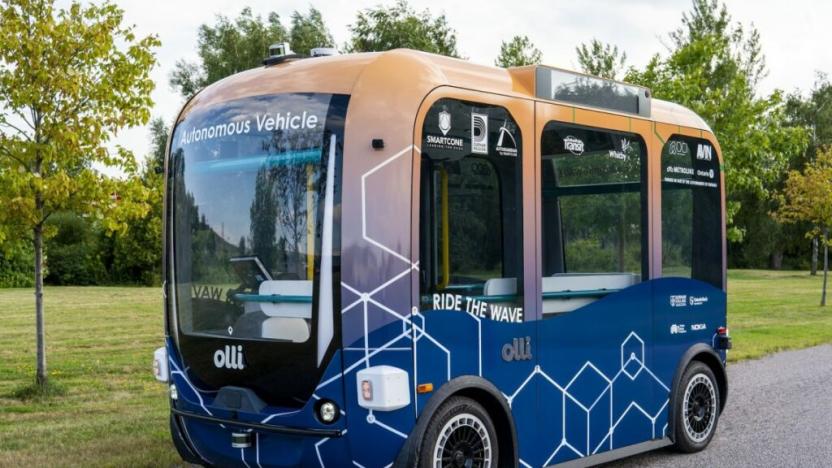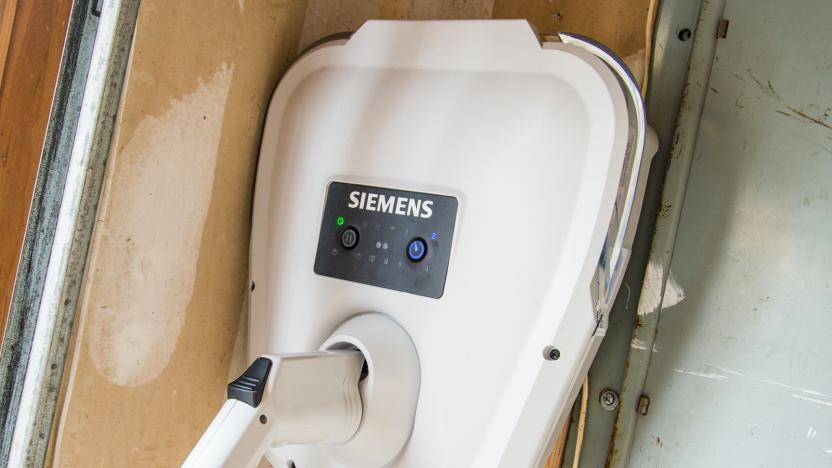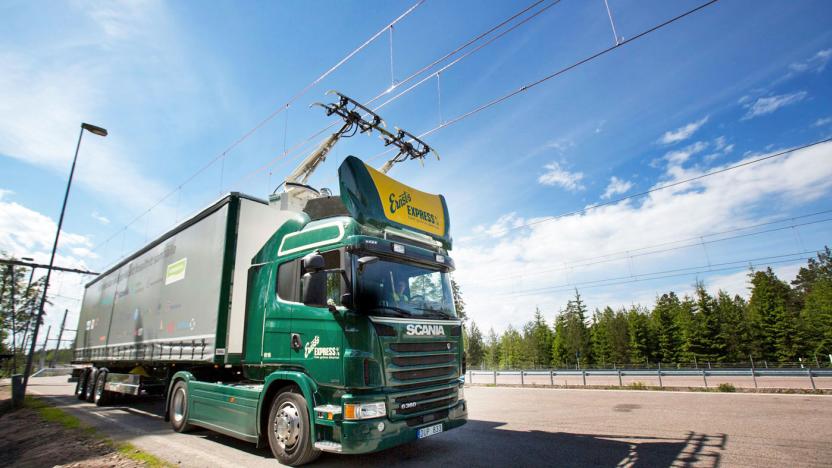siemens
Latest

Sony’s new spatial headset will power whatever 'the industrial metaverse’ is
Shortly after Sony teased the “spatial content creation” device onstage at CES 2024, we got a fresh look, and a few more details about the headset during Siemens’ keynote in Las Vegas.
Karissa Bell01.08.2024
After 15 years, Local Motors will reportedly cease operations this Friday
Crowdsourcing automaker Local Motors will cease operations this Friday, according to employees,
Andrew Tarantola01.13.2022
The best EV charging stations
By Eric C. Evarts This post was done in partnership with Wirecutter. When readers choose to buy Wirecutter's independently chosen editorial picks, it may earn affiliate commissions that support its work. Read the full article here. After more than 50 hours researching over 70 charging stations for electric cars and testing five of the most promising models, we've concluded that the best for most owners of current electric vehicles (EVs) is the Siemens VersiCharge VC30GRYU, though Tesla owners should just buy Tesla's own charging station. The Siemens isn't the most powerful unit and doesn't have the most features, but it's the most convenient to use and the least expensive, and it's powerful enough to quickly charge most EVs, proving that you don't need to spend a fortune to get a great home-charging station for your electric car.
Wirecutter05.04.2018
Airbus, Rolls-Royce and Siemens team on a hybrid electric aircraft
Purely electric aircraft are still in their relative infancy. Hybrid aircraft, however? They're closer than you think. Airbus, Rolls-Royce and Siemens are partnering on a hybrid electric aircraft prototype, the E-Fan X, that will prove the mixture of conventional and electric engines will work. The demonstrator will modify a BAe 146 by replacing one of its gas turbine engines with a 2MW electric motor, followed by a second if everything goes smoothly. It's currently slated to fly sometime in 2020.
Jon Fingas11.28.2017
Robot uses machine-learning to grab objects on the first try
Training robots how to grasp various objects without dropping them usually requires a lot of practice. But a new robot, designed by researchers at UC Berkeley and Siemens and described in an upcoming paper, can learn how to grip new objects just by studying a database of 3D shapes.
Mallory Locklear05.25.2017
Six technological breakthroughs inspired by nature
By Cat DiStasio Biomimicry is an incredible field that seeks to unlock nature's deepest, darkest secrets and then use them to solve human problems. Many of the scientific breakthroughs in biomimicry have far-reaching applications ranging from new medical technologies, to methods of space exploration, advancements in renewable energy and better, cleaner and stronger building materials. The approach investigates nature's designs and seeks to replicate its processes to improve people's lives in the most efficient way possible. Inspiration can come from the most unlikely places, including long-extinct dinosaurs, sticky-footed geckos, deep sea creatures and even the structure of the tiniest green leaf. Read on to learn just a few examples of how scientists are mimicking the amazing abilities of plants and animals.
Inhabitat07.09.2016
Sweden debuts the world's first 'electric highway'
Fossil fuels are bad for the planet, and freight haulage is one of the more carbon-intensive activities that operate today. That's why Siemens and Scania have teamed up to trial what's being called the world's first "electric highway." Much like an electrified railroad, the 1.2 mile stretch has a series of wires hanging overhead that a pantograph-equipped truck can connect to. Then, the vehicle can deactivate its fuel-burning engine and coast along on that delicious, dirt-cheap electricity, switching back when the wires stop.
Daniel Cooper06.24.2016
Recommended Reading: Gary Numan's fascination with Moog synths
His friend electric: Gary Numan and the Moog DJ Pangburn, The Quietus The list of musicians Gary Numan has influenced is a mile long. During his three-night residency at Moogfest in May, the artist sat down with The Quietus to discuss lots of things, but in particular, his decades-long affinity for Moog synths.
Billy Steele06.11.2016
'FriWalk' is a mobility walker and a personal trainer in one
If there is one area of personal transport that is ripe for innovation, it's probably the mobility walker. Typically reserved for older generations -- complete with the stereotypical tennis ball feet (like the one used by Carl Fredricksen in Pixar's Up) -- the walker has remained largely unchanged for decades. As part of the EU's ACANTO project, researchers from six European countries have developed the Friendly Robot Walker or FriWalk, a new four wheeled walker that is fitted with depth sensors and cameras that can detect health risks from a user's gait but also serve as a personal trainer.
Matt Brian06.01.2016
Dyson loses fight to change EU power efficiency label laws
The world of vacuum cleaners isn't exactly known for its gripping legal drama... except maybe for the one Dyson has found itself in recently. After launching legal action against the European Commission last year over new (and potentially discriminatory) energy efficiency rules for vacuum cleaners, Dyson now faces the ugly end of an EU General Court verdict. According to the BBC, the Court dismissed the whole of Dyson's argument earlier today because it couldn't come up with more reliable power tests that should be used instead.
Chris Velazco11.11.2015
Dyson says vacuum makers are cheating efficiency tests, VW style
As far as Dyson is concerned, Volkswagen isn't the only company that should be taken to task over shady efficiency testing. The company's just launched legal proceedings against Bosch in the Netherlands and Siemens in Germany, claiming its competitors are slapping misleadingly high energy efficiency ratings on their vacuum cleaners. Siemen's Q8.0 and Bosch's GL80/In'Genius ProPerform models both sport AAAA ratings, based on power consumption measurements of 750W. But according to Dyson's internal tests, this figure can jump to more than 1600W -- the maximum EU regulations allow for vacuum cleaners -- in real-world conditions. Chugging that much electricity would supposedly land those products in E/F rating territory, far from the AAAA label advertised.
Jamie Rigg10.21.2015
Hearing aid uses your smartphone to target sound in a noisy room
Siemens has revealed new smart hearing aids that will definitely leave your grandpa's old model in the dust. The "wearable hearing tech" can automatically kill noise and let you control the microphone's direction with a smartphone to better pick up a voice in a noisy room. Siemens says the tech has been "clinically proven to outperform people with normal hearing in background noise." The system works with an Android or iOS "easyTek" app to help you better hear sounds in any direction, especially with two hearing aids. They can even act as a glorified Bluetooth headset for your smartphone, or operate independently without it. The exact prices and model numbers have yet to be revealed, but we're planning on giving them a try soon here at CES 2015 -- who doesn't want bionic hearing?
Steve Dent01.05.2015
Bosch wants to run the power for all of your connected kitchen appliances
Until today, we thought that Bosch's HomeConnect system would only let you turn your washing machine on if you had Bosch (or Siemens)-branded hardware. Turns out, however, that the company wants to be the middleman for all of your internet-connected appliances. At an event in Turkey, a spokesperson revealed that HomeConnect will become a platform that'll let you control all of your kitchen gadgets, no matter which company makes them. That way, instead of having a smartphone chock-full of apps, each one dedicated to a separate appliance, it could all be run from HomeConnect.
Daniel Cooper04.25.2014
Nokia buys controlling stake of Nokia Siemens Networks for $2.2b
That didn't take long -- just hours after Bloomberg reported that Nokia was planning to buy out its German partner, the two firms have made it official: Nokia Siemens Networks is about to become a fully owned subsidiary of Espoo. The €1.7 billion ($2.2 billion) buyout will eventually see the Siemens name dropped from the network, naturally, though Nokia hasn't yet announced what the restructured entity will be called. The transaction isn't a complete surprise, of course -- earlier this year Siemens CFO Joe Kaeser told Dow Jones Newswires that 2013 was the year his company would help "NSN to move into a better place," announcing plans to separate from the partnership. Kaeser continued the thought in today's announcement, calling Nokia's new acquisition as "an attractive opportunity to actively shape the telecom equipment market for the future and create sustainable value." Nokia head honcho Stephen Elop echoed the sentiment, speaking highly of NSN's recent financial growth and looking ahead to future ventures. Read on for Nokia and Siemens official press release, complete with quotes, statements and financial specifics.
Sean Buckley07.01.2013
Bloomberg: Nokia will buy Siemens' share of joint venture for less than $2.6b
Not all partnerships pan out, and Nokia seems ready to call it quits: according to Bloomberg, the company might announce a buy out of the German half of Nokia Siemens Networks later this week. Sources familiar with the matter say that the the Finnish firm is planning to use a bridge loan to finance the $2.6 billion purchase (less than 2 billion euros), taking the entire operation under its own wing. It's not a completely unexpected move on Nokia's part -- the company previously avoided selling off stake in the network back in 2011, opting to lean on its own shareholders instead. Bloomberg reports that Siemens has declined to comment on the issue, but we'll let you know if we hear anything solid.
Sean Buckley06.30.2013
Amtrak to roll out high-efficiency trains with regenerative braking (video)
Some of us look at electric trains as efficient transportation almost by definition, but that's not entirely true when they consume a lot of power and give little back. Amtrak is about to strike a better balance now that it's close to receiving the first of 70 high-efficiency Siemens ACS-64 trains destined for routes across DC, Massachusetts, New York and Pennsylvania. Each engine centers on a regenerative braking system that can recover up to 5MW of energy, much of which goes back to the power grid. The machinery is smarter, too: it can self-diagnose problems and mitigate the impact until repairs are possible. Commuters won't immediately notice the difference when ACS-64 trains reach the rails between this fall and 2016, but there should be important behind-the-scenes savings. Amtrak reckons that the new vehicles could lower energy consumption by 3 billion kilowatts in the long run, which might help both the company's bottom line and local utilities.
Jon Fingas05.14.2013
Siemens' waterproof Aquaris hearing aid means rain doesn't need to stop play, we go ears on
Being deaf or hearing impaired may present technological challenges, especially if you are fond of the great outdoors and all the weather-related perils that come with it. Siemens knows this and developed the Aquaris hearing aid, the only one to receive an IP68 rating for continuous submersion underwater (to three feet). It's also dust- and shock-proof, if you're further up the extreme activity lifestyle ladder. It's not just about keeping the elements out, it's also got Bluetooth, meaning wearers can listen to music on smartphones and other devices while underwater. The device itself is what you might imagine a hearing aid to look like, if it was given the sports treatment, which makes it attractive to younger folk, and those of an active disposition. Most importantly, it works impressively well, which was amply shown by the demonstration we were given with the device permanently submerged in water at the booth, streaming its audio to another device. The waterproof functionality doesn't come at the expense of the sound, either, with the Aquaris sporting high-definition sound with 48 channels with high frequency resolution and a 12 kHz frequency range. Given the nature of the device, you'll need to speak with your physician or ENT / otolaryngologist if this sounds like something for you. Available now. Follow all the latest CES 2013 news at our event hub. Sean Cooper contributed to this report.
James Trew01.06.2013
Nokia's Q2 2012 financials: 4 million Lumias sold, $1.01 billion dollar loss
The past three months haven't been the best for Finland's former world number one. It hasn't been helped by the three biggest credit agencies lowering the company's bond rating to "junk," and the Lumia 900's violently slashed price. Unfortunately the latest results reveal continuing gloom: the manufacturer made an operating loss of $1.01 billion dollars for the quarter. The company managed to make €7.5 billion in sales ($9.2 billion, down .5 billion since the last quarter), shifting four million Lumia handsets in the process. In fact, the only cause for optimism is that sales of the Lumia range have roughly doubled each quarter. The number of handsets pushed out the door increased (thanks to the Asha range of budget phones) with the company selling 73 million phones. That said, the company has clearly failed to crack America, selling a paltry 600,000 handsets in the States. The cash pile has also continued to dwindle, with the piggybank currently standing at €4.1 billion ($5.1 billion), down from $6.3 billion in Q1, despite getting a further $250 million in kickbacks from Microsoft. Unsurprisingly, the prediction for the third quarter of the year was similarly dour, summed up rather euphemistically as "difficult."
Daniel Cooper07.19.2012
First solar-geo plant blooms in Nevada's high desert
Drive west on US Route 50 through a stretch of Nevada highway known as "The Loneliest Road in America" and you'll eventually find yourself in the rural county of Churchill. Once a solitary leg in the Pony Express route, irrigation transformed swaths of Churchill's high desert areas into thriving agricultural communities more than a century ago. Fast forward to today and Churchill finds itself playing host to yet another interesting dichotomy -- a first-of-its-kind power plant that generates electricity by harvesting renewable resources from both earth and sky. %Gallery-159924%
Jason Hidalgo07.13.2012
AMD Piledriver cores will clock over 4GHz, employ 'resonant clock mesh'
AMD's Trinity APU can do some remarkable things, but we still don't know exactly what magic ingredients make its Piledriver cores superior to the tepidly received Bulldozer. Now though, a firm called Cyclos claims it's supplying 'resonant clock mesh' power-saving technology for use in the new module. In speaking to the media, it's revealed that this will help to enable a "4+ GHz" factory clock speed, which sounds high if it definitely refers to an integrated chip with low-power credentials. As for the resonant clock mesh itself, it's a bit like KERS for processors: it recycles clock power instead of letting it dissipate and thereby enables higher clock speeds in "next generation SoCs that also require ultra-low power consumption." We also know that the technology is financially backed by ARM and Siemens and has seen precious little implementation prior to AMD -- which is fine, so long as all that resonance doesn't make our rig hum even louder.
Sharif Sakr02.22.2012